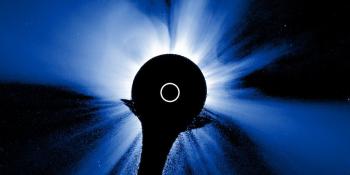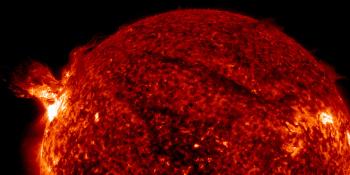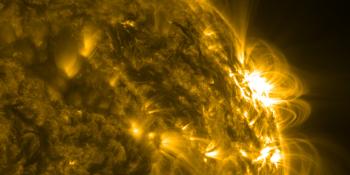Space Weather Forecast - Discussion
Issued: 2025 Dec 22 0030 UTC
Prepared by the U.S. Dept. of Commerce, NOAA, Space Weather Prediction Center and processed by SpaceWeatherLive.com
Solar activity
24 h Summary
Solar activity reached moderate levels with an M1.3 at 21/1827 from Region 4316 (S08E26, Dri/beta), which has been exhibiting rapid flux emergence on the western edge of its leading spot. Region 4317 (N11E64, Cao/beta) produced most of the C-flare activity observed this period, and continued to exhibit growth though confidence in its classification is low due to foreshortening effects. The remaining regions were either stable or in decay. No Earth-directed CMEs were detected in available coronagraph imagery.Forecast
Solar activity is likely to be at low levels with a slight chance (20%) for M-class flares through 23 Dec, with 24 Dec increasing to a chance (30%).Energetic Particles
24 h Summary
The greater than 2 MeV electron flux reached high levels with a peak flux of 1,570 pfu observed. The greater than 10 MeV proton flux was steady at background levels.Forecast
The greater than 2 MeV electron flux is expected to be at normal to moderate levels on 21-23 Dec, with a possible threshold crossing on 24 Dec. The greater than 10 MeV proton flux is expected to persist at background levels through 24 Dec.Solar Wind
24 h Summary
The solar wind environment became enhanced this period with the onset of CIR effects beginning at around 21/0000 UTC. Total magnetic field strength (Bt) reached a peak of 15 nT, with the Bz component showing an almost periodic oscillation between +/- 10 nT for several hours before decreasing to roughly +/- 3 nT. Solar wind speeds increased from a low of around 450 km/s to a peak near 700 km/s. Phi was mostly positive throughout the period.Forecast
Enhanced solar wind conditions are expected to prevail over 22-24 Dec due to CIR effects followed by positive polarity CH HSS influences.Geospace
24 h Summary
The geomagnetic field reached G1 (Minor) storming levels this period in response to CIR effects.Forecast
The geomagnetic field is expected to continue reaching active levels 22-24 Dec, due to persistent CH HSS influences. Periods of G1 (Minor) storming are likely, with a chance for G2 (Moderate) storm periods, on 22-23 Dec.Latest news
Latest forum messages
CH 09 13AR 4316 9Incoming & Unnumbered Active Regions 53Current Farside Activity 260Space Weather Memes 765
More topicsSupport SpaceWeatherLive.com!
A lot of people come to SpaceWeatherLive to follow the Solar activity or if there is a chance to see the aurora, but with more traffic comes higher costs to keep the servers online. If you like SpaceWeatherLive and want to support the project you can choose a subscription for an ad-free site or consider a donation. With your help we can keep SpaceWeatherLive online!
Space weather facts
| Last X-flare | 2025/12/08 | X1.1 |
| Last M-flare | 2025/12/21 | M1.3 |
| Last geomagnetic storm | 2025/12/21 | Kp5 (G1) |
| Spotless days | |
|---|---|
| Last spotless day | 2022/06/08 |
| Monthly mean Sunspot Number | |
|---|---|
| November 2025 | 91.8 -22.8 |
| December 2025 | 116.9 +25.1 |
| Last 30 days | 109 +22.2 |





